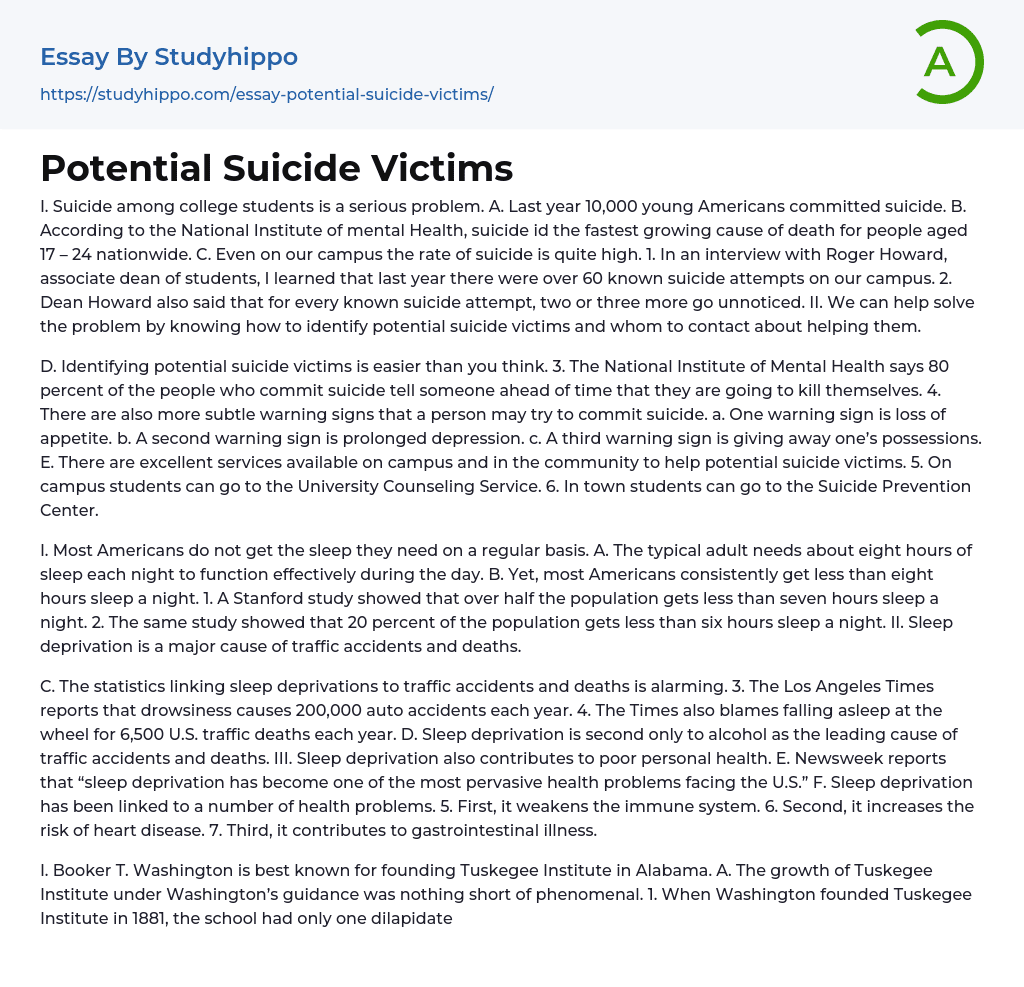I. Suicide among college students is a serious problem. A. Last year 10,000 young Americans committed suicide. B. According to the National Institute of mental Health, suicide id the fastest growing cause of death for people aged 17 – 24 nationwide. C. Even on our campus the rate of suicide is quite high. 1. In an interview with Roger Howard, associate dean of students, I learned that last year there were over 60 known suicide attempts on our campus. 2. Dean Howard also said that for every known suicide attempt, two or three more go unnoticed. II. We can help solve the problem by knowing how to identify potential suicide victims and whom to contact about helping them.
D. Identifying potential suicide victims is easier than you think. 3. The National Institute of Mental Health says 80 p
...ercent of the people who commit suicide tell someone ahead of time that they are going to kill themselves. 4. There are also more subtle warning signs that a person may try to commit suicide. a. One warning sign is loss of appetite. b. A second warning sign is prolonged depression. c. A third warning sign is giving away one’s possessions. E. There are excellent services available on campus and in the community to help potential suicide victims. 5. On campus students can go to the University Counseling Service. 6. In town students can go to the Suicide Prevention Center.
I. Most Americans do not get the sleep they need on a regular basis. A. The typical adult needs about eight hours of sleep each night to function effectively during the day
B. Yet, most Americans consistently get less than eight hours sleep a night. 1. A Stanford study showed that over half the population gets less than seven hours sleep a night. 2. The same study showed that 20 percent of the population gets less than six hours sleep a night. II. Sleep deprivation is a major cause of traffic accidents and deaths.
C. The statistics linking sleep deprivations to traffic accidents and deaths is alarming. 3. The Los Angeles Times reports that drowsiness causes 200,000 auto accidents each year. 4. The Times also blames falling asleep at the wheel for 6,500 U.S. traffic deaths each year. D. Sleep deprivation is second only to alcohol as the leading cause of traffic accidents and deaths. III. Sleep deprivation also contributes to poor personal health. E. Newsweek reports that “sleep deprivation has become one of the most pervasive health problems facing the U.S.” F. Sleep deprivation has been linked to a number of health problems. 5. First, it weakens the immune system. 6. Second, it increases the risk of heart disease. 7. Third, it contributes to gastrointestinal illness.
I. Booker T. Washington is best known for founding Tuskegee Institute in Alabama. A. The growth of Tuskegee Institute under Washington’s guidance was nothing short of phenomenal. 1. When Washington founded Tuskegee Institute in 1881, the school had only one dilapidated building and enrollment of 40 students. 2. By the time Washington died in 1915, Tuskegee Institute occupied 2,000 acres of land, enrolled 1,500 students, and boasted a faculty of 200 instructors. B. Today, Tuskegee Institute remains a leader in applied research and practical education. II. Washington is also
known as one of the ablest speakers in American history.
C. All told, Washington delivered some 4,000 public speeches during his 30-year career as an orator. D. Washington’s most famous speech is his “Atlanta Exposition Address” of 1895. 3. In the “Atlanta Exposition Address” Washington urged blacks to strive for economic advancement rather than to agitate for immediate social equality. 4. To this day, Washington’s speech at Atlanta remains highly controversial. a. Some people praise the speech as a brilliant example of audience adaptation in a very difficult situation. b. Other people condemn the speech for failing to denounce racial segregation and inequality.
- Anatomy and Physiology essays
- Addiction essays
- Biodegradation essays
- Dental Care essays
- Disease essays
- Disorders essays
- Health Care essays
- Intelligence Quotient essays
- Nutrition essays
- Olfaction essays
- Public Health essays
- Women's Health essays
- World health organization essays
- Cancer essays
- Infectious Disease essays
- Lung Cancer essays
- Neurology essays
- Physical Exercise essays
- Medicine essays
- Sex essays
- Inquiry essays
- Disability essays
- Poison essays
- Action Potential essays
- Nervous System essays
- Childbirth essays
- Puberty essays
- Blood essays
- Kidney essays
- Neuron essays
- Body essays
- Glucose essays
- Sense essays
- Heart essays
- Skeleton essays
- Human Physiology essays
- Eye essays
- Immune System essays
- Muscle essays
- Skin essays
- Brain essays
- Central Nervous System essays
- Human Skin Color essays
- Digestive System essays
- Common sense essays
- Respiration essays
- alcoholism essays
- Smoking essays
- Casino essays
- Tobacco essays




